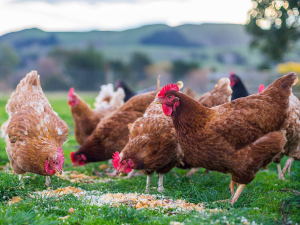MPI defends cost of new biosecurity lab
The head of the Ministry for Primary Industries (MPI) biosecurity operation, Stuart Anderson, has defended the cost and the need for a Plant Healht and Environment Laboratory (PHEL) being built in Auckland.
 Over the weekend, test results confirmed the virus had spread to the final layer shed, something Anderson says was not unexpected.
Over the weekend, test results confirmed the virus had spread to the final layer shed, something Anderson says was not unexpected.
Biosecurity New Zealand says continued testing and monitoring shows no signs of avian influenza outside of Mainland Poultry’s Hillgrove, Otago farm.
Depopulation efforts are currently underway and are expected to be completed today, says Biosecurity New Zealand deputy director-general Stuart Anderson.
The farm remains under a strict biosecurity lockdown.
“The depopulation to date covers all four layer sheds, which held a capacity of 160,000 chickens in total,” Anderson says. “We’ve had an animal welfare specialist on site to observe depopulation operations.”
Over the weekend, test results confirmed the virus had spread to the final layer shed, something Anderson says was not unexpected.
“We had already planned to depopulate this shed before those results came in as we knew that spread was almost certain,” he says.
A separate facility on the farm, away from the layer sheds and housing 40,000 rearing chickens, will also be cleared.
The depopulation of that facility will begin today.
“International experience tells us there is no other way to manage the risk of spread of this virus other than full farm depopulation, followed by cleaning, and decontamination,” Anderson says.
“We’ve moved quickly in the past week to put in restrictions, investigate, track, and test, and I thank the farmer involved and our industry partners for their help – together we’ve made strong progress,” he adds.
Over 1,200 samples have been received to date, with hundreds still being analysed at a time in Biosecurity New Zealand’s PC3 laboratory in Wallaceville in Wellington.
The response team has over 200 staff members across the Ministry for Primary Industries.
“We continue to put significant resource into eliminating H7N6, and we are confident we are on the right track to stamp it out,” says Anderson.
There remains no risk to eggs and chicken supply in New Zealand given the size of the national flock, nor any issues for food safety, and the risk to human health remains low.
According to Ravensdown's most recent Market Outlook report, a combination of geopolitical movements and volatile market responses are impacting the global fertiliser landscape.
Environment Canterbury, alongside industry partners and a group of farmers, is encouraging farmers to consider composting as an environmentally friendly alternative to offal pits.
A New Zealand dairy industry leader believes the free trade deal announced with India delivers wins for the sector.
The Coalition Government will need the support of at least one opposition party to ratify the free trade deal with India.
Primary sector leaders have welcomed the announcement of a Free Trade Agreement between India and New Zealand.
At Pāmu’s Kepler Farm in Manapouri, mating has wrapped up at the across-breed Beef Progeny Test.

OPINION: The release of the Natural Environment Bill and Planning Bill to replace the Resource Management Act is a red-letter day…
OPINION: Federated Farmers has launched a new campaign, swapping ‘The Twelve Days of Christmas’ for ‘The Twelve Pests of Christmas’ to…